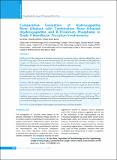Please use this identifier to cite or link to this item:
https://hdl.handle.net/20.500.14356/915Full metadata record
| DC Field | Value | Language |
|---|---|---|
| dc.contributor.author | Bista, Soni | - |
| dc.contributor.author | Adhikari, Khushbu | - |
| dc.contributor.author | Baniya, Bikash Kumar | - |
| dc.date.accessioned | 2023-04-05T07:38:01Z | - |
| dc.date.available | 2023-04-05T07:38:01Z | - |
| dc.date.issued | 2022 | - |
| dc.identifier.citation | BistaS., AdhikariK., & Baniya B. K. (2022). Comparative Evaluation of Hydroxyapatite Bone Alloplast with Combination Bone Alloplast (Hydroxyapatitie and ?-Tricalcium Phosphate) in Grade II Mandibular Furcation Involvements. Journal of Nepal Health Research Council, 20(02), 510-516. https://doi.org/10.33314/jnhrc.v20i02.3796 | en_US |
| dc.identifier.issn | Print ISSN: 1727-5482; Online ISSN: 1999-6217 | - |
| dc.identifier.uri | http://103.69.126.140:8080/handle/20.500.14356/915 | - |
| dc.description | Original Article | en_US |
| dc.description.abstract | Abstract Background: The management of furcation involvements by regenerative surgery with bone alloplast have been used with varying degrees of success in periodontal therapy. The aim of the study was to clinically and radiographically compare the effectiveness of Hydroxyapatite bone alloplast with combination bone alloplast (Hydroxyapatite and ?-Tricalcium phosphate) for the treatment of Grade II mandibular furcation involvements. Methods: Thirty patients with bilateral Grade II mandibular furcation involvements were distributed in Group A (Hydroxyapatite) and Group B (Hydroxyapatite and ?-Tricalcium phosphate). Clinical parameters such as Plaque Index, Gingival Index, Probing Pocket Depth, Clinical Attachment Level and Horizontal Probing Depth were recorded at baseline and at one, three and six mths postoperatively. Radiographic bone fill measurements were recorded at baseline and six months post-operatively. Results: Both the groups showed statistically significant (p <0.01) improvement in clinical and radiographic parameters at each recall visits. Inter-group comparison of clinical parameters showed no significant difference in both the groups whereas radiographic measurements following six months post-surgery showed significantly (p <0.05) greater amount of bone fill in Group B compared to Group A. Conclusions: It can be concluded that at six months post-operative, both the alloplastic materials resulted in significant improvement in clinical parameters and no significant difference was found between both groups. There was a statistically significant radiographic bone fill when a combination of Hydroxyapatite and ?-Tricalcium phosphate was used demontrating its effectiveness in the treatment of Grade II Furcation involvement. Keywords: Calcium phosphates; hydroxyapatite; periodontal index; tricalcium phosphate | en_US |
| dc.language.iso | en | en_US |
| dc.publisher | Nepal Health Research Council | en_US |
| dc.subject | Calcium phosphates | en_US |
| dc.subject | Hydroxyapatite | en_US |
| dc.subject | Periodontal index | en_US |
| dc.subject | Tricalcium phosphate | en_US |
| dc.title | Comparative Evaluation of Hydroxyapatite Bone Alloplast with Combination Bone Alloplast (Hydroxyapatitie and ?-Tricalcium Phosphate) in Grade II Mandibular Furcation Involvements | en_US |
| dc.type | Journal Article | en_US |
| Appears in Collections: | Vol 20 No 02 Issue 55 April-June, 2022 | |
Files in This Item:
| File | Description | Size | Format | |
|---|---|---|---|---|
| 3796-Manuscript-29708-1-10-20221103.pdf | Full Article. | 238.47 kB | Adobe PDF |  View/Open |
Items in DSpace are protected by copyright, with all rights reserved, unless otherwise indicated.
